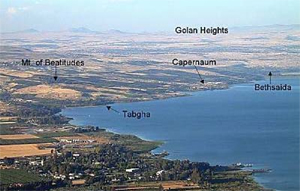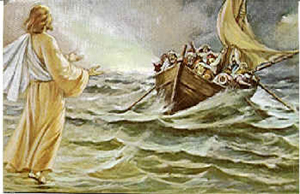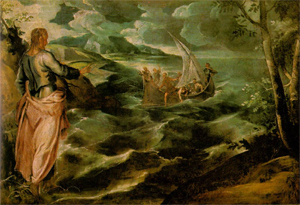
Christmas
Easter
Pentcoest
All Saints
Christ The King
Confirmation
Palm/Passion
Reformation
Stewardship
Books of the Bible
Lenten Series
Christmas Dramas
Videos
Series A - Matthew
Series B - Mark
Series C - Luke
Series D - Other
To contact
Edward F. Markquart
info@sfs.com

Series A Walking on Water Gospel Analysis PENTECOST 12A Matthew 14:22-33 PENTECOST 7B John 6:1-21 Pastor Edward F. Markquart The following Bible study is from a larger course entitled THE LIFE OF CHRIST: A Study in the Four Gospels. This 54 week course for the laity will be available for congregations in 2006. Basic text for the course: SYNOPSIS OF THE FOUR GOSPELS, Kurt Aland, English Edition, P. 138. #147. THE WALKING ON THE WATER Matthew 14:22-33; Mark 6:45-52, John 6:16-21 This is another gospel text that needs to be carefully studied. Most of us are aware of the gospel stories where Jesus walked on water. For us in the twentieth century world, there are certain miracles of Jesus that grab our attention more than others because there are no apparent psychological explanations for the occurrence of those miracles. That is, we modern people may rationalize about healings (Jesus healed people with severe mental problems) and feeding five thousand (Jesus transformed selfish hearts), but it is more difficult to rationalize other miracles of Jesus such as the turning of water into wine and walking on the water. This miracle of walking on water grabs our attention and we need to examine it carefully. In the Gospel of John, the reader would have expected to go directly from the miracle of Jesus feeding of the 5000 to the teaching of Jesus about the Bread of life. But in between the feeding of the 5000 and the teaching about the Bread of life, we hear the story of walking on water. Raymond Brown, in his famous commentary on John, comments: “Since it would have been simpler for the fourth evangelist, if he were simply a creative artist, to have placed the discourse on bread immediately after the multiplication, his inclusion of the walking on the sea indicates that he was controlled by an earlier tradition in which the multiplication and walking on the sea were already joined.” (THE GOSPEL ACCORDING TO JOHN, V. I, p. 252). Let us carefully examine the texts. We especially like the historicity of the gospel accounts from both Peter (Mark) and John. We notice there are gospel parallels which are woven into the story:
-Immediately he made his disciples get into the boat and go on ahead to the other side, to Bethsaida, while he dismissed the crowd. Jesus had just finished feeding the 5000. Mark tells us that the destination of the disciples was the village of Bethsaida; John tells us that the destination was Capernaum which was two miles nearer than Capernaum. Imagine a boat rowing/sailing from Tabgha to Capernaum or Bethsaida. Examine the following photograph so you can imagine the route along the shore from Tabgha to Capernaum.
-After saying farewell to them, he went up on the mountain to pray. We look at the above photograph and see the Mount of Beatitudes where Jesus gave his teachings called the Sermon on the Mount. -When evening came, the boat was out on the sea, and he was alone on the land. The disciples were in the boat rowing to their destination; Jesus was alone of the seashore. Although Mark does not say it, Jesus had returned from the Mount of Beatitudes where he had been praying and was now alone on the seashore. That is, Jesus could actually see the disciples from his vantage point on the shore. We remember from Lesson 6 that the remnants of a 2,000 year old fishing boat from the northwest shores of the Sea of Galilee. This boat was 26 feet long and 7 feet wide and could carry 15 people.
-When he saw that they were straining at the oars against an adverse wind, From the land, Jesus could see to boat out in the water and the disciples pulling on the oars against an adverse wind. -When they had rowed about three or four miles (only John).John tells us the disciples had rowed about three to four miles (Footnote M at the bottom of the page, “in Greek, twenty-five or thirty stadia.”) Matthew tells us they had rowed many furlongs distance. In other words, the disciples had rowed three to four miles from their original point of embarkation, Tabhga, and after three or four miles of rowing, they would have been close to Capernaum. -He came towards them early in the morning, walking on the sea. See the comments by Barclay in the next section. Circle the word, “on.” Focus on the image of Jesus walking “on” the sea. In the next section, we will hear that certain commentators think that the Greek language suggests that Jesus was walking “by” the sea rather than “on” the sea. Such commentators quote John 21:1, where the key Greek word is translated “walking by the seashore.” http://www.biblia.com/jesusm/water.htm
http://www.wga.hu/art/t/tintoret/2religio/galilee.jpg
-He intended to pass them by. -But when they saw him walking on the sea, they thought it was a ghost and cried out; for they all saw him and were terrified. The disciples thought that they were seeing a ghost and were terrified by what they saw. We remember that later in the story about Jesus’ resurrection appearances, the disciples thought they were seeing a ghost. -But immediately he spoke to them and said, "Take heart, it is I; do not be afraid." Underline. Highlight. Focus on. Christ/God are constantly inviting us to take heart and not be afraid of the storms what we are facing in life. -Then he got into the boat with them and the wind ceased. And they were utterly astounded, for they did not understand about the loaves, but their hearts were hardened. When Jesus got into the boat, the winds ceased and they were astounded and amazed. The miracle is that Jesus controlled the wind and the waves, as he did earlier when he calmed the storm. The miracle of this particular story was that Jesus stilled the storm. -Peter answered him, "Lord, if it is you, command me to come to you on the water." Matthew’s edited this story and this incident is only found in Matthew’s gospel. Peter, the leading disciple, is going to come out onto the water. As in all the Peter stories, Peter is pro-active and the first to speak or take action. We remember other stories about Peter and his being pro-active: the call of the first disciples, the Mount of Transfiguration, the Garden of Gethsemane, in the court yard of the high priest (cock crowing), his professing faith that we disciples will never deny you, his cutting off of the ear of the high priest’s servant, his telling Jesus at the last resurrection appearance that he will be the loyal shepherd. Peter always seems to be “pro-active” and in the middle of the action. - He said, "Come." So Peter got out of the boat, started walking on the water, and came toward Jesus. We find Peter starting to walk on water and experiencing a miracle. But when he noticed the strong wind, he became frightened, and beginning to sink, he cried out, "Lord, save me!" Here is the problem: Peter took his eyes and his faith off of Jesus Christ. Peter began to focus on the storm raging about him. He became afraid and began to sink. He cried out, “Lord, save me.” That is our situation all the time. We take our eyes off of Christ and focus on the storm and begin to sink and drown. -Jesus immediately reached out his hand and caught him, saying to him, "You of little faith, why did you doubt?" Jesus did not let Peter sink and drown. Jesus caught Peter when he was drowning and will catch us as well. Jesus will also ask a basic and simple question of us: “Why were you doubting me in the middle of your storm?” -When they got into the boat, the wind ceased. And those in the boat worshiped him, saying, "Truly you are the Son of God." This is the miracle. Not that Peter walked on water for a few steps. Not that Jesus walked on water. The miracle is that Jesus calmed the storm on the lake with his word of command. Realizing this, the disciples in the boat worshipped him and confessed that he was/is the Son of God. That is what Jesus wants from you and me: to realize that Jesus is more powerful than nature, to realize that Jesus is none other than the Son of God, that Jesus is the mind and heart of God in the flesh of a human being. Jesus wants us to worship him as much as we worship God the Father, God the Creator. Some people title this story as “Jesus walking on water” and the miraculous essence of this story is that Jesus walked on the water. The way that a person titles the event shapes the way we see the event. Other people title this story as “Jesus calming the storm.” The miracle was when Jesus calmed the storms in nature and when he controls the storms in our lives. DISCUSISON QUESTION: SHARE A STORY FROM YOUR OWN LIFE WHERE YOU TOOK YOUR EYES OFF OF CHRIST/GOD AND INSTEAD FOCUSED ON THE STORM THAT WAS SURROUNDING YOU. A footnote. The following comments are a perspective about walking “on” water by a believing rationalist, William Barclay, in his commentary, THE GOSPEL OF JOHN, V. 2, p. 208. Barclay offers us a different perspective to this story. Most of us have not previously thought about Barclay’s viewpoint. For a moment, let us try to get into the thought pattern of the modern rationalist, Barclay. A critical phrase in this story is “walking on the sea.” The key issue is the translation: “on the sea” or “by the sea.” Let those two prepositions sink into your mind: “on the sea” verses “by the sea.” Barclay writes in his commentary, “The Greek is ‘epi tes thalasses’ which is precisely the phrase used in John 21:1, where it means—it has never been questioned—that Jesus was walking on the seashore. That is what the phrase means in our passage too.” (Briefly turn to p. 336 in your text, THE SYNOPSIS OF THE FOUR GOSPELS and underline John 20:1, “by the sea.” The same Greek words in John 6:19 are translated, “on the sea.”) Barclay continues, “Jesus was walking bythe seashore. The toiling disciples looked up and suddenly saw him. It was all so unexpected. They had been bent so long over their oars that they were alarmed because they thought it was a spirit they were seeing. … Remember that the breadth of the lake was four miles at this end of the lake and that they had already rowed that distance. The simple reason is that before they could take Jesus on board, the boat grounded on the shingle (land) and they were there.” If Barclay’s analysis of this story is true, the miracle or sign would not be the walking on the water so much as it is the calming of the wind. The title of this event would not be “Jesus walking on the water” but “Jesus calming the storm.” This miracle would be then similar to Jesus’ stilling of the storm that we read about on p. 77 (Jesus stilling the storm) and in which Jesus demonstrated his power over nature. The preaching theme of the story becomes Jesus’ words, “Take heart; do not be afraid. It is I.” Jesus’ comforting and strengthening words occurred in the middle of a storm, as they do in the middle of the storms of our lives. A question is: “Why were the disciples utterly astounded?” Because of Jesus walking on water and/or because the wind ceased? In either interpretation, the story tells that Jesus had power over nature and the story becomes another significant miracle that confirms that Jesus was/is the Son of God, the Mind and Heart of God in human flesh. At the conclusion of the story, both Matthew and Mark say that the wind ceased and the disciples worshipped him or were utterly astounded by what happened. Unconsciously, we title this miracle, “Walking on Water,” and not “Calming the Wind.” The title that we give to this miracle affects the way we think about it. In Barclay’s thought pattern, Matthew has an additional story about Peter walking on water and then sinking. For Barclay, this would be a later addition to the more original story by Mark and John. In Matthew’s story about Peter, Peter sinks into the water, presupposing a greater depth of water. It is only the Gospel of Matthew that has the story about Peter sinking in the surf. The Gospels of Mark and John do not. Scholars like Barclay would suggest that this section of the Matthew story is a later addition to the earlier accounts by John Mark (via Peter) and John. Both Peter and John are to be considered eyewitnesses. For many scholars, Matthew is not. For scholars like Barclay, the walking on the water story still communicates its essential message without the additional story about Peter. What is the essential message of this story? Jesus is the Son of God who calmed the storming wind, whereby the disciples were astonished and worshipped him. The Peter story also fits with the teaching of Jesus, “Take heart. Do not be afraid. It is I.” From another commentary, Bible Gateway. http://www.biblegateway.com/cgi-bin/webcommentary?language=english&version=niv&book=john&chapter=6 “In these six verses two miracles are recorded that each reveal Jesus as the master over the natural realm. The first is his walking on the water to reach the disciples. Many have suggested that John does not intend for us to believe Jesus walked upon water but that John is saying Jesus was walking along the shore next to the sea. The Greek language allows such an interpretation (epi tes thalasses has this meaning in 21:1.” Excerpts from a sermon about Jesus walking on the water: “We need to be reminded that the concept of miracles is part of our everyday modern life and experience. The word, “miracle,” and the experience of the miraculous, is in no way confined to Biblical times or the first century. The word, “miracle,” and the experience of the miraculous, is very much part of our modern world and our everyday lives. In spite of all the technological advances and scientific sophistication, the word, “miracle,” is still very much part of our contemporary vocabulary and the experience of the miraculous is very much part of our everyday lives. Let me illustrate. You open the refrigerator door and you pull out a jar of Miracle Whip, a mayonnaise that spreads so nicely across your bread. Or you pull out a small, flat bag and put it into the microwave, and “wallah!,” it puffs up and you have instant popcorn, and you say, “What a miracle!” ... You go out to the garden and you pour Miracle Grow onto your plants and they flourish so splendidly, thanks to Miracle Grow. ... A rocket is shot up into the air and a man for the first time plants his first footprint on the moon, and everybody called it a miracle ... It wasn’t that many years ago that penicillin was discovered and everyone called it a miracle drug. Soon after that, in the early 1950s, Dr. Salk discovered the Salk vaccine to vaccinated against polio and all of our parents said it was a miracle. And recently, the smallpox vaccination was given to children throughout the whole earth and there is not one case of smallpox anywhere on the globe and everybody would agree that is a miracle. And when a vaccination or the equivalent is discovered for cancer or cancers, the headlines will shout for joy: “Miracle drug found for cancer!” ... There was a car accident the other day and the body of the car was totally smashed, and those who saw the car exclaimed: “It is a miracle that anyone came out of that smashed car alive.” ... Births and adoptions often evoke the word, miracle. A baby is born, and the parents almost automatically say, “This is a miracle,” and the parents who have been struggling with infertility for five, ten, or fifteen years, when their child is born, truly believe that their child is a miraculous gift from God. What I am suggesting to you is that the word, “miracle,” and the experience of the miraculous is not confined to Biblical times and the first century. The word, “miracle,” and the experience of the miraculous is interwoven throughout our modern lives. We use the word, “miracle,” all the time. Miracles aren’t necessarily Biblical magic which confounds the mind such as the body levitating or floating in air; or the magic of a shorter leg miraculously stretching out three to four inches. The focus of miracles isn’t on some magical voodoo or natural laws that have been violated. Rather, a God given miracle is a series of events and the timing of events in such a way that convince us that God has intervened in our lives. The result of such miraculous intervention is the experience of awe and adoration. That is, we go “wow!” and then we worship God in thanksgiving for the miracle. It is with this understanding that we approach the miracle story for today, Jesus walking on the water. We need to create the setting. In Matthew’s Gospel, we have seen Jesus do several miracles in a row. Jesus stilled the storm on Lake Galilee and this demonstrated his power over nature. Jesus then raised Jairus’ daughter from the dead which demonstrated his power over death. Jesus then cured the sick which demonstrated his power over disease. Jesus then caste out demons, which showed his power over the demonic. In the previous story, Jesus has just fed five thousand men plus women and children with five loaves of bread and two fish, and this demonstrated his power over selfishness. In other words, the miracle of the walking on the water occurs immediately after several other miracle stories in the Gospel of Matthew. Walking on the water demonstrates his power over nature. In a similar way, Jesus stilling the storm on Lake Galilee also demonstrates his power over nature. And Jesus, after feeding the five thousand, Jesus sent the crowds home and sent his disciples out in a boat in Lake Galilee. Lake Galilee is a large lake, eight miles wide by thirteen miles long. Jesus himself went up into the hills to pray. Meanwhile, a vicious storm came up on the lake. The waves were enormous as the disciples were rowing in the middle of the storm in the middle of the night. It was about three o’clock in the middle of the night, and the disciples were frightened, terrified, by the storm. And suddenly, Jesus appeared to the disciples, walking on the water. The Bible says that the disciples were frightened, terrified, crying out, utterly astounded by what they saw, as if they were seeing a ghost. Their reaction wasn’t, “There is Jesus, just like we expected, walking on the water. He must be God.” No, the disciples were frightened, shocked, and stunned by what they experienced. Jesus, seeing their fears, said to them, “Do not be afraid; it is I.” And so also, the Lord Jesus, seeing our fears and insecurities, says to us: “Don’t be afraid of me. Do not be afraid.” Then Peter, in Matthew’s gospel, being brave of heart or a bit foolish, asked, “Jesus, can I come onto the water?” Jesus said, “Come,” And Peter came. He kept his eyes focused on Jesus, on the face of Jesus, on the eyes of Jesus, on the presence of Jesus. But then suddenly Peter’s eyes were diverted away from Jesus and he focused on the wind, on the water raging about him, on the storm. Doubts overwhelmed him and he started to sink, crying out, “save me.” And Jesus, immediately, not waiting for five seconds or five minutes to teach Peter a lesson, “immediately,” the Bible says, Jesus reached out to Peter and saved him. And when they got into the boat, the storm calmed and the disciples were in awe, in fearful reverence of Jesus, and they worshipped him as the Son of God. They praised him in thanksgiving for saving them. Not being able to explain what happened or how it happened, those disciples believed that they had experienced a miracle; that the sequence of events and timing of events convinced them that God, that Christ, had intervened and saved their lives. And what was their reaction? They experienced awe and holiness. They worshipped him in thanksgiving. They concluded: “Truly, Jesus is the Son of God. A few comments. When we experience a miracle in the Bible or in real life, we often want to explain what is unexplainable. And so we rationalize and intellectualize, trying to figure out what happened. We think like Greeks who wanted a reason for evewrything. For example, we try to explain the walking on the water. You perhaps have heard this joke. I have heard it what seems a thousand times. A rabbi, a priest and a Lutheran pastor were fishing in a boat together, not far from land. The rabbi used up all his bait, noticed a bait shop a short ways away, got out of the boat, walked on water to the bait shop, returned the boat, walked back on water and started fishing again. A short time later, the priest ran out of bait, walked on water over to the bait shop and back again and started fishing. Then, the Lutheran pastor ran out of bait, had a look of doubt on his face, stepped out of the boat and sank. The rabbi and priest said: “Hey, dummy, don’t you know where the reef is?” ..... What a sick joke. It’s a groaner. If I have heard it once, I have heard it a thousand times. It is the kind of joke that church members love to tell their pastor. Behind that joke, there is the rationalization, the attempt to explain how Jesus walked on water. He walked on a reef. Jesus knew where the reef was but Peter didn’t and sank. Or some commentators will legitimately suggest that the Greek language implied that Jesus walked “beside the water,” and the disciples thought he was walking on water. The disciples couldn’t clearly see in the storm that Jesus was walking beside the water, not on the water. These are attempts to rationalize, to explain, to think like a Greek, and ask “how did this happen.” But what I am suggesting is that something happened that night that we and they don’t quite understand, but in the sequence of events and in the timing of those events, they experienced the miraculous saving power of God in their lives. That’s the miracle, the experience of God’s intervening and saving Presence in their lives. It’s not magic. It’s not proving how it happened. That’s the wrong focus. What I am suggesting to you is that the disciples were in a boat in the middle of a ferocious storm and were scared spitless, thinking that they were going to die. Jesus came to them, walking on the water and saved them. They were awestruck by what they experienced, encountering the holiness of God, and then they worshipped Christ as the Son of God in appreciation for what he had done for them. They couldn’t explain it; anymore than we can explain miracles that happen to us. I am always amazed at the large number of people who tell me that they are a “walking miracle;” that God has intervened and saved them, rescued them, healed them, strengthened them; that they could not have made it without God. I hear such comments often, and the focus is never on the how the miracle happened or rational explanations for the miracle or the magic of it. The focus is always on God’s intervention in their lives and their deepest appreciation for God’s deliverance. The focus is not on thehow but on God’s miraculous deliverance. The focus is not on explanations but on deliverance. And such people worship God, praise God, thank God for all God’s goodness. A second comment about this miracle: Peter sinking in the waves of the storm. As a little boy, going to worship every Sunday morning of my life, that picture of Peter sinking in the waves of the storm was the center of our church’s altarpiece. It was a picture of Peter, outside the boat, sinking in the turbulent waves, Jesus holding onto Peter’s arm, rescuing him. Every Sunday morning, we sang the hymn “Holy, Holy, Holy” and looked at that picture of Simon Peter as he was doubting Jesus and sinking into the water. The picture was vividly engraved into the souls of many of us whose altars had the same picture of Peter sinking in the storm. A person cannot help but concentrate on Simon Peter; how he got out onto the water with his eyes focused on the eyes of Jesus, on the face of Jesus, on the Presence of Jesus; and there for a moment of doubt, his eyes were diverted to the wind, to the storm, to the size of the waves; and he sank. And so it is with us so often in our lives. Rather than focusing on the eyes of Jesus, the face of Jesus, the Presence of Jesus, we focus on the storm which is raging in our lives and we start to sink...because we are focusing on the storm rather than on the saving Presence of God in our lives. The story is told by “old salt” sailors of how to climb the mainsail to the crow’s nest, high above the wooden sailing vessel. On an old sailing ship, there is a tall mainsail and the crow’s nest is perched there, at the very top of the highest mainsail. In your imagination, can you see the crow’s nest up there at the top of the mast? It is scary enough to climb to the crow’s nest when the sea is smooth and calm; but it is very frightening to climb to top of the mainsail and into the crow’s nest in the middle of a raging storm. The sea vessel is swaying this direction and that, and the movement at the top of the mainsail sways even more, as the boat rocks back and forth. The old sailors tell you, when climbing to the crow’s nest in the middle of a raging storm, never ever look down....or you will fall. Never look down into the storm or you won’t make it. Remain keenly aware of the storm all around you, but don’t look down into the storm or you will get sick and fall. Keep your eye looking up at the crow’s nest. And so it is with us: in the middle of the nastiest storms of life, and the storms of life can be so nasty, it is wise, so very wise, to keep our focus up on God, up on the face of Christ, up on the strength and power of God, rather than on the storm. I have heard it so often: “I would not have made it through that storm if I hadn’t focused on Christ, on the cross, on God. I had to keep looking up to God to survive.” Keep your eyes on the crow’s nest in the storm! Keep your eyes up on the face of Christ! At the core of the story is Jesus’ statement: “Take heart. Do not be afraid. It is I.” We are perpetually afraid of the next chapter in our lives. We are afraid of the storms of life: the report of the doctor that our loved one has a terminal disease, the advice that we need to move out away from what has been our home for fifty years, the evaluation that we no longer have our job. Into the storms of our lives, Jesus says, “Take heart. Do not be afraid. It is I. I am with you.” And, when it was all said and done, these series of miracles convinced the disciples and the early church that Jesus was the Son of God. These people of the Bible experienced several miracles in a row: the stilling of the storm, the raising of Jairus’ daughter, the healing of the lepers, the casting out of demons, the feeding of the five thousand, then the walking on water and deliverance from the storm. And finally, the disciples slowly came to the conclusion and realization, “Truly, this is the Son of God.” And they worshipped Christ as Lord. And through a series of events in our lives, incomprehensible to us, God works on us and in us in such a way that we, too, are stopped in our tracks and slowly we come to the realization: “Jesus, you are the Son of God. We worship you.” Miracles. The experience of the miraculous. I have found that the word, “miracle,” and the experience of the miraculous is not confined to the Bible and the first century. I have found that the word, “miracle,” and the experience of the miraculous, is very much a part of the modern world, very much a part of your life and mine. Amen.” (End of sermon) |



